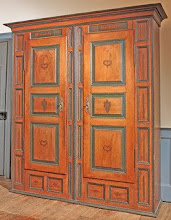We've been awfully quiet for the past week or so. Sorry for the long silence, but Andrew is about to stagger over the finish line for a catalogue deadline, and then he promises to tell you all about his trip east for Winterthur's Furniture Forum and the Philadelphia shows.
Meanwhile, I've been working a little on our transcription project. Joshua Shipman was one of the early settlers in Marietta, Ohio, and his name kept popping up during Andrew's thesis research. We were so disappointed to discover that although the Washington County Public Library had a Shipman document, it was just what appeared to be the front page of his daybook. But, while combing through a box of miscellaneous papers related to early Marietta history, Andrew came across a daybook and thought, "Hmm. This seems to be about the same size as that Shipman page." A comparison immediately revealed that he was right and in one of those magic research moments, this daybook transformed into an important resource.
Shipman's daybook, which covers the years of 1796 to 1803, shows what a booming town Marietta was. In the first three years or so, he produced over 70 pieces of furniture, some of them very specific forms. It also shows what diversity was necessary to earn a living - a talented cabinetmaker, Shipman also records entries for fence-building, pulleys for the ship industry, and renting out oxen. We're hoping that a complete transcription and study of the daybook will offer some insight into the life of the average frontier cabinetmaker as well as shed some light on how hard settlers worked to create a sense of civilization through stylish homes.
Every time we start a project, I discover all over again how fascinating it is to rummage around in the documentary record and try to construct lives for people. Especially with research centering around an early small town, it seems that you often start to feel as though you know the people. Their names certainly become familiar, and somehow, I find myself able to recite the names of more people living in Marietta in 1790 than living in Sunbury in 2009. You start to build hopes for them, these people that you can never truly know and, more importantly, these people whose fates have long been sealed, to feel sad when you see an entry in Shipman's daybook for a child's coffin or to feel a kinship when you see inventories with more books than chairs.
Research is one of the most life-affirming things I've ever done - seeing the continuity of human hopes and experiences, the way we all struggle to carve out a space for ourselves or to feather our nests a little more comfortably. With the nation struggling in such a fashion, I find it comforting to look back, to remember the terrible shape America was in immediately after the Revolution, with debts and political rifts and uncertainty, and to know that in the microcosm of a little muddy Ohio River town, people were still going about the business of living: treasuring books, fixing up their homes, working hard to support their families. Life does, in fact, go on.
Thursday, April 23, 2009
Subscribe to:
Post Comments (Atom)


2 comments:
Neat that you guys are working on mid western/ ohio furniture makers/ forms. Every art form needs a champion to get the recognition it deserves. Let us not forget that in the 1920s no american museums collected american furniture as it was considered inferior to european design/craftsmanship. Along came Israel Sack & Wallace Nutting and BAM, EVERYTHING changed.
In the 1960s, a curator gave a lecture at some forum or other and let this little gem slip out " american southern furniture forms are unworthy of collecting". No curator ever did more in the cause of research into southern decorative arts as that comment did.
Appreciate the kind words, James. Here's hoping for the BAM moment in the next couple of decades!!
Post a Comment